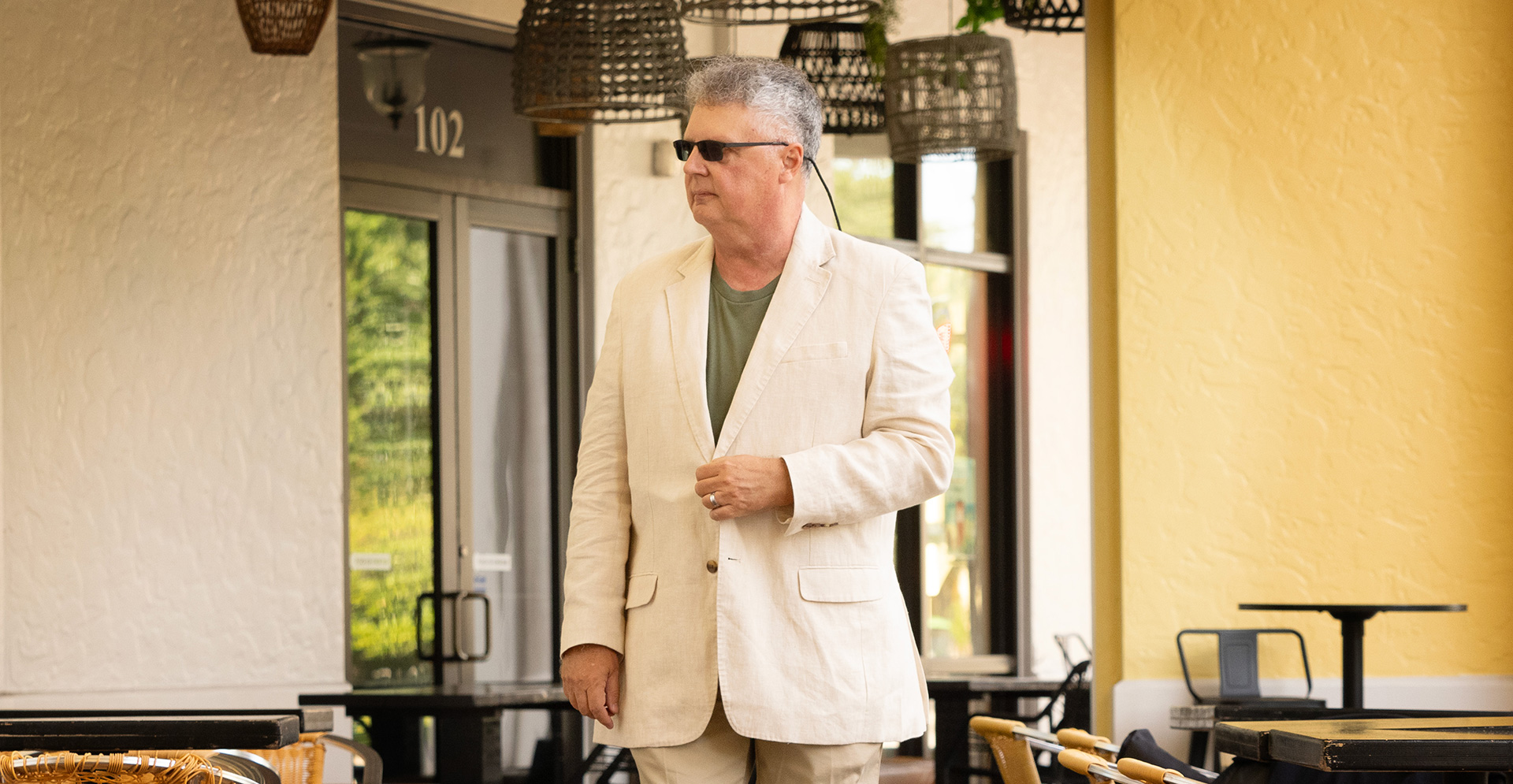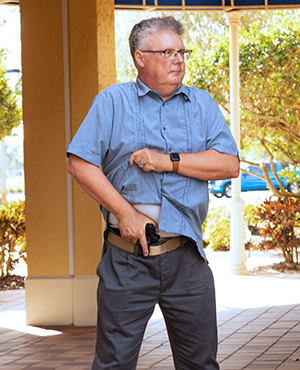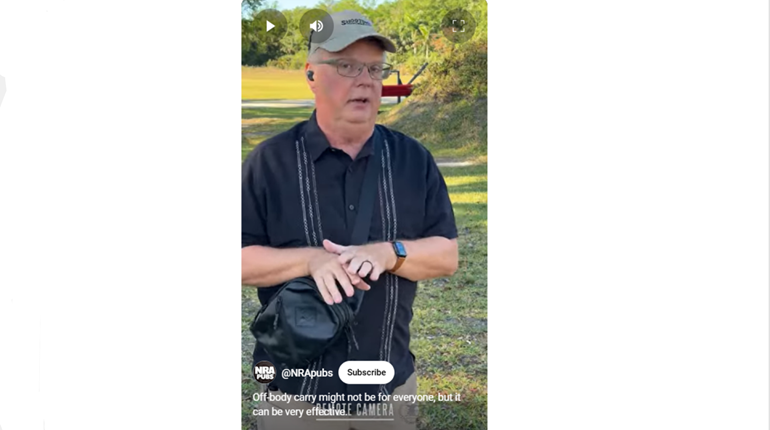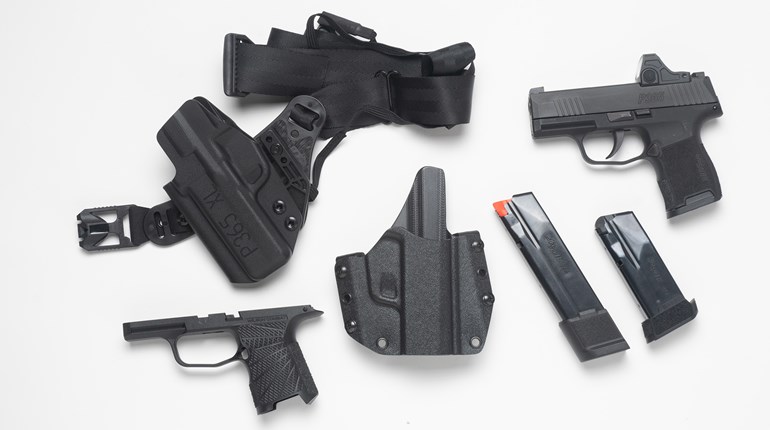
Choosing to carry a defensive pistol means making adjustments in your lifestyle. Even innocuous, low-impact methods of concealed carry, like pocket carry and off-body carry, will force you to change your life in some way. Pocket carry means you’ll need to re-sort your life so you’ll have an empty pocket to store your gun, and off-body carry means choosing from a limited selection of bags or purses which can safely store your gun.
Those changes don’t have to be drastic, though, and with a bare minimum of effort, you can be dressed to the nines while carrying a 9mm.
Or a .38. Or a .45.
To help ease this transition, we talk with two people on the cutting edge of both how to dress well and how to have a firearm with you when you need it the most.
Tessah Booth
Director of Customer Development, Phlster Holsters
What got you into concealed carry?
I was raised around guns, but I married a gun guy who was on the West Point Pistol team, so I started shooting more often so I could be with him more. It didn’t come naturally, though, until we moved to El Paso and due to a high-profile criminal attack, I realized that I could be the victim of a violent crime, and that I had to do something as a response. My first concealed carry gun was a Glock G42, and I started taking firearm-training classes. Dressing in a feminine manner has always been a part of my personality, and I was initially concerned that choosing to carry a gun meant that I would have to take on a more masculine style. Instead of relegating myself to this assumption I chose to try my best to stay true to my style of dress while also making an effort not to compromise on important holster features such as retention, trigger protection and reliable access.

How do you get around the fact that most women’s clothing doesn’t have belt loops and pockets?
This was initially difficult for me, as there’s a lot of bad information out there and a lack of correction about poor practices. My first holster was a belly band holster, but I found I could manipulate the trigger from outside the holster, which I and pretty much everyone else consider to be unsafe.
So I decided to try carrying like my husband carries, with a gun belt in a Kydex holster, but it was almost impossible to wear skirts and dresses with a gun belt on.
It was around then that I first heard about the Enigma, and I realized that it would solve a lot of the problems I ran into as a woman who wants to carry concealed. I reached out to PHLster, and they sent me one to try out. I’m 5 feet, zero inches tall, so a Glock G19 on me is like concealing a G34 on a larger person. I started to work out how I would use that Enigma in my everyday life, and with some effort, made it work for me, and now I work for the company that makes it.
When it comes to pockets, most of the pockets on women's clothing are sealed shut or are just 1 or 2 inches deep. As a result, there really aren’t the same options for pocket carry for women as there are for men.
How do you work around the fact that men and women have different hip shapes?
IWB holsters and gun belts are tougher for women, due to our body shapes. In general, men are more boxy-shaped and women are more curvy-shaped. As men age, a belt becomes more and more essential for them to hold their pants up, while women tend to have higher waistlines and more hips, reducing the need for a belt. Overall, our pants also fit tighter, reducing the need for a belt. All this combines to create an environment where it’s harder for women to carry inside the waistband
What about off-body carry?
When it comes to off-body carry, there are places in our country and times in our lives when off-body carry makes sense, such as living in cold climes where dressing warmly means limited access to your gun. However, for me, I’ve found that the restrictions needed to do off-body carry in a safe manner, like keeping your purse on you when you’re in someone’s home or keeping it on you, rather than in a cart as you grocery shop are just not something I’ve been willing to explore.
It’s a cliché that guys who carry conceal under a Hawaiian shirt or “shoot me first” vest. What are the female equivalents of that sort of clothing?
It’s honestly very similar, as I see women wearing gun company t-shirts and think “They’re carrying.” Men tend to dress like off-duty cops more regularly, but also I see women doing the same thing. Also, our bags can tell people that we may be carrying, as we tend to carry bags that are obviously meant for concealed carry.
What am I not talking about?
“The concealment percentage principle.” Bigger guns are harder to conceal, and as a result, smaller people have a harder time carrying concealed, so there is a trade off between what people my size can carry discreetly. Guns that are frequently recommended as a baseline for concealed carry for most people, like the Glock G19 or similar, can be difficult for someone my size to conceal.
As a result, I worked out that for AIWB (Appendix Inside the Waistband) carry, if the total height of your gun is 40 percent or less of the distance from hip bone to hip bone across the front, you should be good to go. 40-50 percent of that distance takes some work to conceal and 50 percent or more means you’ve got to change your wardrobe and “dress around the gun.”
Also, fabric selection is important. My first couple of years, I learned that the fabric of our clothes makes a difference. Synthetic fabrics can be comfortable, but they can also cause problems. For instance, synthetic knit clothing tends to cling to the body, while woven natural fibers work very well as they tend to hang looser on the body.
Alex Sansone
The Suited Shootist
What got you into all of this?
I started The Suited Shootist because when I went from working retail at a gun counter to working in an office, I realized that what gun people consider to be “normal and acceptable clothing” was far different than what’s considered to be normal and acceptable in the corporate world, and what gun people consider to be “normal” was very difficult to pull off in the business world. I started to explore how to ramp up the level of discreteness I could use in places where it was legally permissible but socially awkward if discovered, if I was discovered, while still having an effective deterrent with me. The tradeoff I found was how I could balance carrying a smaller gun in say, a pocket holster, versus something that larger, but is harder to get to in a hurry.

So why bother dressing well? I can wear an oversized T-shirt and hide a small howitzer: Why should I wear nicer clothes?
For starters, I shouldn’t have to live my life around the gun, as there is more to my life than my gun. Secondly, how you dress impacts your behavior. For example, we know that dressing nice while working from home affects your attitude to your job. The other pushback about dressing nicely is that people think this is about wearing formal or fancy clothes. It’s quite possible to look great in casual clothes, or to look like a bag of hammers while wearing a tuxedo, it just depends how much effort you put into it. In many ways, it’s like firearms training: People don’t see the benefit of putting in the effort to get proficient with a gun, but the benefit is there, it’s just not as obvious as other things.
How do you ramp it up beyond just a t-shirt and jeans?
It’s fairly simple. There are two routes, depending on your level of effort. The safest bet is going with something like dark denim, leather shoes and solid colored shirts. A nice pair of dark jeans, a white button-down shirt and leather shoes works just about anywhere.
As an alternative, find a person you respect and see how much of their style you can adopt and make your own. It’s going to take effort, because a “casual style” just doesn’t just happen.
When it comes to holsters, there is no way to copy someone else’s solution and make it work for you. Your style, shape and life are different than anyone else’s, so you’ll need to take what they’re doing and work at it so it becomes your own.

Dressing nice sometimes means tucking in your shirt. How do you deal with that?
I have three preferred methods. The first is the PHLster Enigma, which is the easiest way to carry the most gun. You can wear it AIWB, with your shirt tucked in over the gun, or you can deep carry below the waistline up front and put the holster in between your shirt and your pants.
The second is using DCC Behind The Belt Clips with an AIWB or IWB holster. These are the best solution for AIWB/IWB carry, as they hide the clips when your shirt is tucked in. However, your pants need to fit well for this to work, as the holster needs to be held firmly against the pelvis and the clips just hold the holster in place. This solution is better-suited to smaller guns, as they place less weight on the belt.
The last solution is pocket carry. This can be very discreet when used with smaller guns. It can work with snub-nosed revolvers, but I’ve found that it works best with a small .380 ACP pistol. The great thing about this method is that it allows you to access your gun and get it ready to go in your hand, without looking like you’re about to draw a gun.
So why should people bother to dress nice and while carrying a firearm?
I’m not suggesting that everyone does this, but I live in Houston, and every graduation, wedding or similar event that I go to, I can spot the person with the concealed carry license, because they have little experience dressing well for a nicer social encounter. We encourage people to practice for a relatively rare event like an armed violent encounter, so it makes sense that we encourage people to fit in at nicer events. Putting on a suit is like putting on a gun, it feels weird the first time you do, but you get used to it. I’ve lived in D.C., New Orleans and Houston, and I’ve never had to use a firearm in self defense. However, I have had to wear a suit quite often, and I suspect most other people as well. More than this, dressing well is just polite: If someone values you enough to participate in a significant life event, what message do you want to send them?
What am I not talking about?
People conflate dressing up with dressing well. Dressing up is putting on a costume for Halloween. Dressing well means putting some thought and care into your clothing. The two are not the same.



































